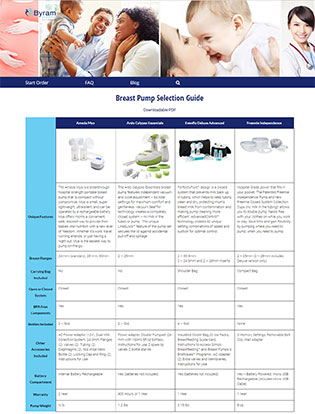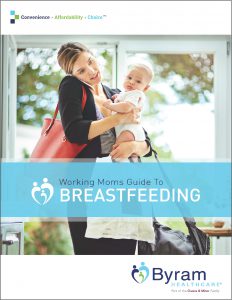What is Cluster Feeding? How to Deal with the Three Different Phases
During the first few weeks of your newborn’s life, you’re going to notice an eating pattern that slowly develops and strengthens. Your baby will need to eat about every three hours; sometimes less, sometimes more. However, as the days pass, you’ll learn your baby’s hunger cues and begin to predict when it’s feeding time, often before your baby begins to cry. You can expect to breastfeed your baby about eight to 12 times within a 24-hour period, but sometimes your baby may need to nurse more often within short periods of time. When this occurs, it’s called cluster feeding. Cluster feeding is also known as bunch feedings and, as the name suggests, it occurs when your baby’s feedings cluster close together around specific times throughout the day or night. To give you more information, we’ll discuss what cluster feeding is and how to deal with the three different phases.
Identifying Cluster Feeding
Many new mothers may not know how to differentiate cluster feeding from the average feeding schedule, especially if their baby hasn’t formed a predictable routine. Cluster feeding has a sudden onset and occurs when your baby begins to stray from their usual eating pattern. It tends to last a few hours at a time and is nothing to be concerned about. Cluster feeding does not mean there is anything wrong with your newborn, but it can cause extra strain for mothers.
Since most babies have fairly unreliable schedules during the first few months of life, identifying cluster feedings can be difficult. Some signs that your baby may be cluster feeding include:
- Showing hunger signs
- Consistent crying until being fed
- Lack of consistent eating
- Eating frequently or for very short sessions each time
- Content behavior during nursing
- Regular wet and dirty diapers
- Early age (within a few days or weeks)
While cluster feeding tends to occur more often in the evenings, it can happen at any part of the day. Cluster feedings are also more common during growth spurts or if your baby is teething.
Normal Feeding Schedules
If you’re not sure how cluster feeding varies from a normal newborn feeding schedule, you’re not alone. Many new mothers have difficulty identifying cluster feeding since it’s so common during the first few days and weeks of your newborn’s life—when feeding schedules have yet to be established. However, a normal nursing session tends to last for about 10 to 30 minutes and occurs up to 12 hours within a 24-hour period. If you’re concerned about your baby’s feeding schedule or duration, talk to your pediatrician today.
Causes of Cluster Feeding
The underlying cause of cluster feeding is still unknown, but there are many theorized factors that are believed to increase its occurrence. One of the biggest suspected causes of cluster feeding is the overall development within your baby. Due to the need for establishing regulation within your newborn’s body, they may need more nutrients at certain parts of the day to help fuel their growth. If your baby is undergoing a growth spurt, it’s understandable that they would need more nourishment. Don’t be alarmed if your baby wants to nurse every 30 minutes to an hour – this is completely normal during the first month or so. Your newborn experiences the most rapid growth in the first two months after birth, so don’t be alarmed. Cluster feeding is considered normal behavior for babies up until about nine months. If you have any questions or concerns, always discuss them with your doctor or pediatrician.

The Difference Between Cluster Feeding and Colic
Typically, cluster feeding coincides with times of the day that your baby is naturally fussier, such as in the evening. However, it should be noted that cluster feeding is not the same as colic. While your baby may fuss as a sign that they want to be fed during periods of cluster feeding, colicky babies are not often soothed by nursing or feedings. Instead, colic occurs when your baby has been crying for at least three hours straight, for at least three days a week, for at least three weeks in a row. Colic is not an uncommon occurrence and affects up to 40% of babies across the world. There’s no identified underlying cause and it doesn’t disproportionately affect any baby differently. Colic can be identified with the presence of screaming, contorted faces or bodies, predictability in crying, and if a baby is under three months old. If your baby shows signs of colic, here are a few things you can do to try and soothe them. If you are unable to find relief for your baby, just hold in there. Colic will eventually pass with time.
The Effect of Cluster Feeding on Milk Supply
Many women get nervous that cluster feeding is an indication that their milk supply is low or not strong enough for their newborn. This is not true. Cluster feeding does not reflect your breast milk supply. In fact, an increase in feedings will actually increase your overall milk supply, since it works on a supply and demand basis. The only time to be concerned is if your baby is not gaining weight or if they’re not producing a normal amount of wet/dirty diapers throughout the day.
How to Deal with the Three Different Phases of Cluster Feeding
Many mothers who deal with cluster feeding begin to feel like they’re doing something wrong. They worry that their baby isn’t getting enough milk, which is why they’re constantly showing signs of hunger. It’s also common for mothers who cluster feed to begin feeling worn-out from the physical and mental demands of ongoing breastfeeding. To help you deal with cluster feeding, here are some tips for each of the three phases you may encounter.
The Newborn Phase
The first phase of cluster feeding is the newborn phase, which occurs within the first 72 hours after birth. While it’s normal to nurse your baby frequently during this time to help establish a strong latch and provide your baby with colostrum, it’s often one of the most exhausting times for new mothers. While you’re going to want to sleep and rest, it’s important that you nurse as often as needed during this time. Doing so will help establish your milk supply and provide your baby with what they need to kickstart development. Ask for help from your partner during this phase. When you’re not feeding, have them hold your baby so that you can rest. If you’re struggling with latching, work with a lactation consultant to address any issues early on.
Growth Spurt Phases
Another common phase of cluster feeding occurs during growth spurts. Some common growth spurt milestones occur at about three weeks, six weeks, three months, and six months. Your baby will likely experience more rapid paced growth at these times, but every child is different so don’t consider these as definitive rules. During growth spurt phases of cluster feedings, ask for help from your partner. By this time, breastfeeding should be established and you can have your partner or a caregiver feed your baby with a bottle and expressed milk. Work to build a milk supply using a breast pump early so you can ask for help with feedings. Breast pumps are a great way to ensure that your baby continues getting nutrient-filled breast milk regardless of who is doing the feedings. You may also want to find a good nipple cream to reduce soreness or irritation from increased feedings.
Evening/Night Phases
One of the most common phases of cluster feeding is evening or nighttime feedings. This is usually the most challenging for new mothers as your milk supply tends to naturally decrease during the evening. In addition, babies tend to be fussier at night, which can combine to create stressful situations. To handle evening or night cluster feedings, try to be prepared. Make sure that you have meals ready and plenty of expressed breast milk, so you can handle whatever comes your way. Building a breast milk backup stash will allow you to supplement feedings between caregivers, which will reduce your strain during cluster feedings at night.
If you’re concerned that your baby is not getting enough milk during feedings, talk to your pediatrician today. This is especially important if your baby isn’t gaining weight, or your baby begins to produce fewer soiled diapers. There are plenty of resources available for new and expecting mothers to handle cluster feedings, such as working with a lactation consultant. To ensure that you’re getting enough rest during this time, Byram Healthcare has a range of insurance covered breast pumps available to new and expecting mothers. Browse our product guide today and get started with our easy, three-step ordering process.





